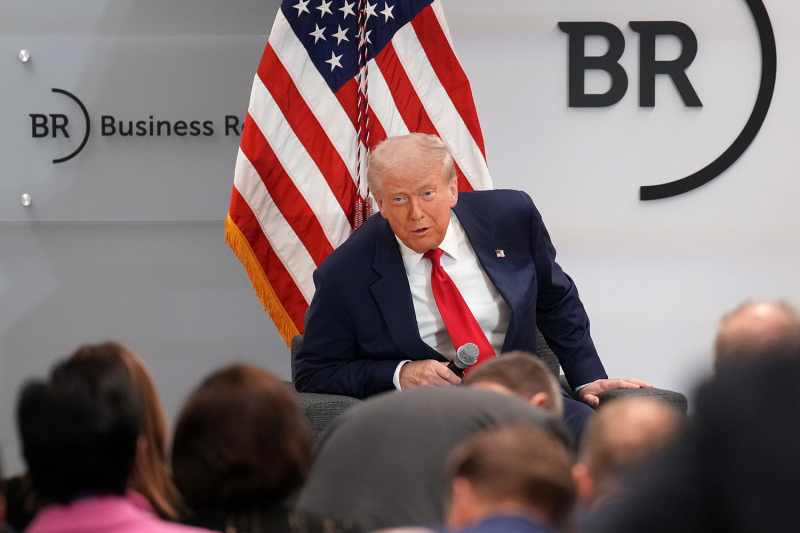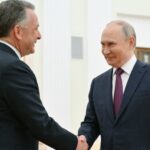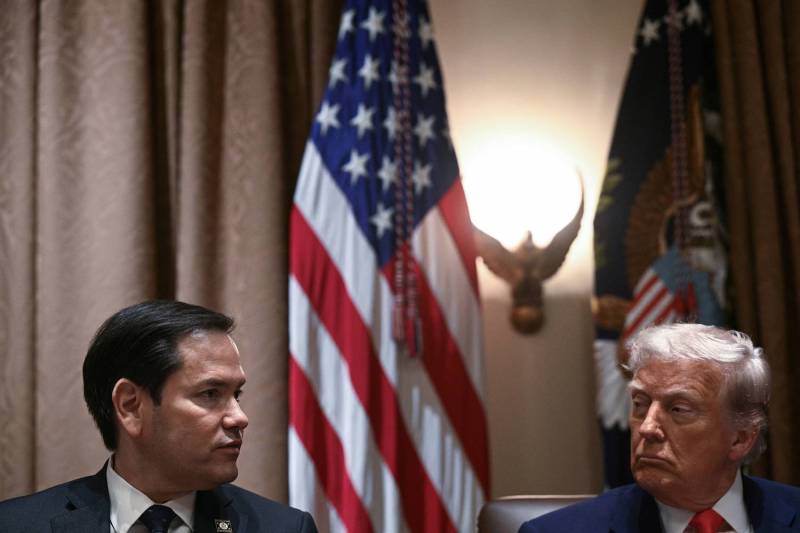What’s Actually on the Table in Trump’s Promised Trade Deals?

What’s Actually on the Table in Trump’s Promised Trade Deals?
Negotiating is a drawn-out process—and the first step is deciding what to talk about.
U.S. President Donald Trump delivers remarks at the Business Roundtable’s quarterly meeting at the Business Roundtable headquarters on March 11, 2025. Andrew Harnik/Getty Images)
How does negotiating a trade deal actually work?
U.S. President Donald Trump has strongly implied that more permanent avoidance of his so-called reciprocal tariffs is available to those who strike a deal before the end of the 90-day pause on his “Liberation Day” tariffs.
How does negotiating a trade deal actually work?
U.S. President Donald Trump has strongly implied that more permanent avoidance of his so-called reciprocal tariffs is available to those who strike a deal before the end of the 90-day pause on his “Liberation Day” tariffs.
The United States has made demands of foreign governments on everything from their tariff policies and trade balances to how they regulate speech on social media. Faced with losing a massively lucrative U.S. market due to the incoming tariffs, Trump hopes that governments will come to Washington and offer to address some or all of these in the hopes of securing an exemption. The president has claimed to already have “made 200 deals.” (Treasury Secretary Scott Bessent later denied this, suggesting that the president may have been referring to “subdeals” within broader trade agreements—itself a misleading statement, as no “subdeal” is agreed to until the full deal is, and many sections of an agreement are uncontroversial and purely administrative.)
But does any of this make sense? The speed at which the United States can do deals and how many it can get done before its (self-imposed) 90-day deadline—July 9—depends on how little the Trump administration is willing to accept from trading partners.
If the United States is OK with largely token gestures such as those offered by Canada and Mexico after they were first hit with tariffs that Trump claimedWA were imposed in response to fentanyl trafficking, then achieving dozens of deals in 90 days is entirely realistic. But if it wants countries to change their tax regimes, reform their entire tariff structures, permanently divest from China, and make laughing at the Tesla Cybertruck a felony, then even 900 days would be insufficient.
Given Trump’s communication style and his relentlessly cultivated brand as a dealmaker, it is unsurprising that expectations are all over the place. Usually, U.S. free trade agreement negotiations involve significantly more transparency—in anticipation for when they will need to be ratified by Congress. This is not the case for the much more limited, transactional deals that the president appears to be pursuing.
Instead, the decision-making process is a black box. Unspecified representatives from an unspecified list of countries engaging with unspecified administration officials in Washington, D.C., to make unspecified offers against unspecified demands in the hopes of winning unspecified concessions—concessions that a U.S. administration that treats compliance with its own treaties and commitments as largely optional might or might not implement to an unspecified degree for an unspecified period of time.
All that ambiguity and mystery causes every passing comment by anyone who might have an insider’s view to be magnified and dissected, as if those such as the Commerce Secretary are ancient gurus sharing wisdom through cryptic aphorisms and not—as may well be the case—learning about half of this stuff in real time on Truth Social along with the rest of us.
But in trying to understand what’s coming out of the White House, it’s useful to know what “normal” looks like in trade negotiations—and how long that can take.
The first step is often determining what each side isn’t talking about. A very important initial phase of any negotiation is a meta-discussion of the type of issues that each side is comfortable with being up for discussion. We can generally assume that tariffs will be—but what about intellectual property? Government procurement? Immigration? Investment controls? Women’s economic empowerment? Environmental regulations?
This stage is especially important with a president who seems to have trouble distinguishing between national interests and his own. Nobody wants to be blindsided with a demand to invest in Trump’s cryptocurrency venture.
When you hear a US official say that they’ve “reached a deal on a framework” or “established terms of reference,” what this mostly means is that the United States has agreed with a partner about all the things it definitely won’t ask it for.
Pre-negotiating to determine the issues that are in and out of bounds lets everyone involved start to think about what they can and can’t accept, without having to worry about something coming out of left field. It’s also very useful politically.
Whenever trade agreement talks loom, the vast majority of questions that are shouted by journalists at the leaders negotiating tend to start with a formulation of, “Can you pledge that this agreement won’t… ?” By ruling entire areas out before the talks even commence, politicians give themselves the confidence to answer such questions definitively, without fear of being proved to be a liar down the track.
In a normal trade negotiation, the pre-negotiation may take one or two rounds, as most such talks are fairly conservative and carried out by officials who are reluctant to venture into new territory. However, because the Trump administration is rather nebulous and changeable about what it actually wants from a lot of countries while also being limited in what it seems prepared to offer (such as a relaxation of the reciprocal tariffs), it keeps trying to broaden the scope of potential topics.
Potential partners are understandably keen on some certainty as to what they might suddenly be asked to pay for a tariff reprieve, but it’s not clear that the officials whom they’re negotiating with have the authority to give it to them.
A typical trade agreement consists of two main elements: the specific commitments that each side makes to the other and the general commitments that apply to both sides.
For example, the United Kingdom’s tariff schedule lists all the tariffs that the U.K. will agree to cut as part of a deal with South Korea along with how much—and how quickly—while the South Korean tariff schedule does the same for the Korean tariffs against the U.K.
Meanwhile, the tariff schedule’s “‘Rules of Origin’” section outlines the procedure for determining if a product is sufficiently homegrown to benefit from these reduced tariffs. This is a general commitment, because it would apply both to U.K. goods flowing to South Korea and South Korean goods flowing to the United Kingdom.
Talks don’t tend to start with a blank page. Instead, the two sides will exchange what are essentially idealized versions of the agreement, roughly following the following steps:
- Here is my initial offer: all the things that I’m happy to give you. This is what my ideal outcome would be if you never asked me for anything else.
- Here is my initial demand: all the things that I would, in an ideal world, love for you to give me.
- Here is my initial draft of the text: how the agreement would look if I were solely in charge of writing all the paragraphs that I care about.
The negotiators then take all of these factors and put them side by side before trying to create a single, consolidated version of a draft final agreement, in which any language that is proposed but not yet agreed is surrounded by square brackets.
From here, talks usually fragment into a range of parallel conversations that are grouped both thematically and by political weight.
In comparing the initial offers, demands, and draft versions of the texts, it very quickly becomes apparent which issues are the ones on which there is profound, high-level, intrinsic disagreement, and on which issues there are differences that might be addressed at a working level, and on which there is broad agreement in principle.
Typically, the negotiators on both sides will then break up into thematic subgroups to try to negotiate mutually acceptable legal language on the parts of the text with which everyone agrees to in principle. Having harvested that low hanging fruit, these negotiators then try to find paths forward on the bits where it seems like a working-level compromise or clever legal fix might work.
At the same time, higher-level negotiators will meet to batter their heads against one another on the big, top-level issues in the hopes of coming to a trade-off that works—or simply convincing the other side to stop asking for something impossible.
It’s very common for the technical negotiations to make progress even as the big-ticket issues remain completely immovable. If you were negotiating your employment contract line by line, then you could probably pretty quickly agree on language for 90 percent of it, even if you and your potential employer were still miles apart on agreeing to a salary and paid family leave. Ultimately, nothing is agreed until everything is agreed.
This creates a confusing dynamic in how secretly conducted negotiations are communicated. It is semantically correct to say that negotiations are “making progress” when the technical work is moving ahead nicely but the big issues are hopelessly stalled. It could also be (very narrowly, dubiously, and misleadingly) semantically correct to describe the smaller compromises reached at the technical level as “deals made.” Yet neither term is necessarily informative.
In a trade negotiation, especially an ad hoc and highly politicized one such as those currently being conducted by the Trump administration, the outstanding question is not whether the technical work can be completed, but whether leaders can find a landing zone on the major issues.
Put more concretely: What is Trump asking countries to give, and are they willing to give it in exchange for what he’s offering?
Technical work in a negotiation aims to narrow down the issues to just a few big political choices, and to find the legal language required to properly capture the intent of the parties to the satisfaction of the lawyers back in capital—it is important, but it is not a substitute for political agreement on the big-ticket items.
At the moment, much of the frustration from U.S. trading partners seeking to negotiate is the absence of a specific request from Washington that they can treat as definitive. Leaked comments from negotiators suggest that they are being asked to effectively bid against themselves, tabling offers based on their best guess of what the United States might want from them and what it might consider sufficient.
If that changes, and if the United States is realistic in what it seeks, then a flurry of so-called deals could come. No country wants to be left out of the U.S. market, especially if its competitors manage to find a way in—but at the same time, countries are very much aware that many of Trump’s tariffs have proved to be as fleeting as Washington’s commitment to past agreements. That means that there’s appetite for a deal that puts these tariffs in the rearview mirror—but not at any price.
Until we start seeing indications of actual progress being made on major issues—and indeed, until we start seeing signed texts—grand pronouncements of progress are probably meaningless. The Trump administration is trying to hold the rest of the world hostage, but it keeps unloading the gun, waving it erratically, and refusing to specify how much it wants in ransom. Braggadocio about the inevitability of triumph should be treated accordingly.
Dmitry Grozoubinski is a senior advisor with Aurora Macro Strategies and the author of the 2024 book Why Politicians Lie About Trade.
More from Foreign Policy
-

A drawn illustration of a Trump whirlwind on a red background Four Explanatory Models for Trump’s Chaos
It’s clear that the second Trump administration is aiming for change—not inertia—in U.S. foreign policy.
-

Marco Rubio is seen up close, sitting on a couch beside J.D. Vance. Marco Rubio’s Soulless Crusade
The U.S. secretary of state stands for no principle other than serving the man who appointed him.
-

Soldiers from various NATO allies take part in a military exercise at the Smardan Training Area in Smardan, Romania, on Feb. 19. America Will Miss Europe’s Dependence When It’s Gone
European self-reliance for security will cost U.S. jobs, profits, and influence.
-

A collage photo illustration shows Donald Trump gesturing with arms wide. In front of him are headshots of Benjamin Netanyahu and Vlodymyr Zelensky, images of immigratns and ICE police, a tattered EU flag and America First signs. Trump’s First 100 Days on the Global Stage
Ten thinkers on what to make of the opening salvo of the president’s second term.








Join the Conversation
Commenting on this and other recent articles is just one benefit of a Foreign Policy subscription.
Already a subscriber?
.
Subscribe
Subscribe
View Comments
Join the Conversation
Join the conversation on this and other recent Foreign Policy articles when you subscribe now.
Subscribe
Subscribe
Not your account?
View Comments
Join the Conversation
Please follow our comment guidelines, stay on topic, and be civil, courteous, and respectful of others’ beliefs.
Change your username |
Log out
Change your username:
CANCEL
Confirm your username to get started.
The default username below has been generated using the first name and last initial on your FP subscriber account. Usernames may be updated at any time and must not contain inappropriate or offensive language.